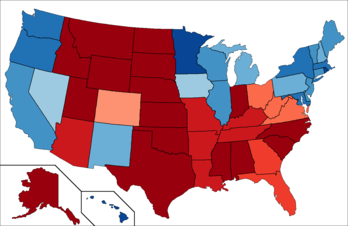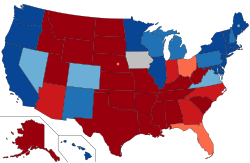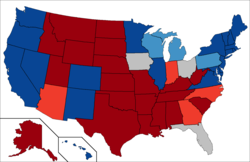Sixth Party System
 | ||
| ||
|
| ||
 United States presidential election results between 1980 and 2020. Blue shaded states usually voted for the Democratic Party, while red shaded states usually voted for the Republican Party. | ||

The Sixth Party System is the era in
Scholarly perspectives
The Sixth Party System is characterized by an electoral shift from the electoral coalitions of the Fifth Party System during the
No clear disciplinary consensus has emerged pinpointing an electoral event responsible for shifting presidential and congressional control since the
According to the 2017 edition of The Logic of American Politics, "a sixth party system is now in place." Although the precise starting date is a matter of debate, "the most salient difference between the current and New Deal party systems is the Republican Party's increased strength, exemplified by 20 majorities in the House and Senate in six straight elections (1994–2004), unprecedented since the fourth party system, [its] retaking of the House in 2010 and the Senate in 2014 [...] and its sweeping national victory in 2016."[7]
Writing in 2020, political scientists Mark D. Brewer and L. Sandy Maisel argue "[i]t seems safe to state that the sixth American party system featured strong divisions between Republicans and Democrats, rooted in cleavages based on social class, social and cultural issues, race and ethnicity, and the proper size and scope of the federal government."[1] In Parties and Elections in America: The Electoral Process (2021), Brewer and Maisel argue that the consensus among experts is that the Sixth System is underway based on American electoral politics since the 1960s, stating: "Although most in the field now believe we are in a sixth party system, there is a fair amount of disagreement about how exactly we arrived at this new system and about its particular contours. Scholars do, however, agree that there has been significant change in American electoral politics since the 1960s."[1]
Dating

Opinions on when the Sixth Party System began include the elections of 1966 to 1968, the election of 1972, the 1980s when both parties began to become more unified and partisan, and the 1990s due to cultural divisions.[8][9][10][11]
Political scientist Stephen C. Craig argues for the 1972 election, when Richard Nixon won a 49-state landslide. He notes that "[t]here seems to be consensus on the appropriate name for the sixth party system. [...] Changes that occurred during the 1960s were so great and so pervasive that they cry out to be called a critical-election period. The new system of candidate-centered parties is so distinct and so portentous that one can no longer deny its existence or its character."[11]
The Princeton Encyclopedia of American Political History dates the start in 1980, with the election of Reagan and a Republican Senate.[12] Arthur Paulson argues that "[w]hether electoral change since the 1960s is called 'realignment' or not, the 'sixth party system' emerged between 1964 and 1972."[13]
Possible Seventh Party System

Some scholars and pundits have also posited that the Sixth Party System has ended while the Seventh Party System has not yet begun, and that the current system is merely a unique transition phase between the two. Mark D. Brewer and L. Sandy Maisel speculate that "in the wake of Donald Trump's 2016 presidential victory, there is now strengthening debate as to whether we are entering a new party system as Trump fundamentally reshapes the Republican party and the Democratic party responds and evolves as well."[14] One argument for a Seventh Party System is a shift in demographics and voting patterns. Non-whites, who predominantly vote Democratic, have grown as a share of the population, and previously Republican-leaning secular college-educated whites have moved to the left. At the same time, Republicans have made significant inroads with white voters without a college degree, while holding steady with evangelical voters.[15] Another noteworthy feature of presidential elections in the 21st century is a consistent Democratic lean in the popular vote. Republicans have lost the popular vote in seven out of the last eight presidential elections. The re-election of George W. Bush in 2004 remains the sole Republican popular vote win since 1988, which stands in significant contrast to the Republican victory streak in the late Fifth and early Sixth Party Systems.[16]
Possible dealignment period

One possible explanation for the lack of an agreed-upon beginning of the Sixth Party System is the brief period of dealignment immediately preceding it. Dealignment is a trend or process whereby a large portion of the electorate abandons its previous partisan affiliation without developing a new one to replace it. Ronald Inglehart and Avram Hochstein identify the time period of the American dealignment as 1958 to 1968.[17] Although the dealignment interpretation remains the consensus view among scholars, a few political scientists argue that partisanship remained so powerful that dealignment was much exaggerated.[18]
Issues
Harris and Tichenor argue: "At the level of issues, the sixth party system was characterized by clashes over what rights to extend to various groups in society. The initial manifestations of these clashes were race-based school desegregation and affirmative action, but women's issues, especially abortion rights, soon gained equal billing. [...] To these were added in the 1980s environmental defense and in the 1990s gay rights."[19]
New voter coalitions included the emergence of the "religious right", which is a combination of Catholics and Evangelical Protestants united on opposition to abortion and same-sex marriage. Southern white voters started voting for Republican presidential candidates in the 1950s, and Republican state and local candidates in the 1990s.[20]
Nominating candidates
In the chaotic campaign for the Democratic nomination in
Campaign finance
Even more dramatic was the increase in spending thanks to new fund-raising techniques. The major growth was not in the business or labor sectors, but in the network organizations of political parties, and most particularly the national organizations of state elected and party officials.[23] The U.S. Supreme Court gave decisive support to reducing limits in Citizens United v. FEC (2010). That decision enabled corporations, labor unions, and Super PACs, among others, to advertise as much as they please within 30 days of a primary election or within 60 days of a general election. Two years before the decision, the 2008 presidential election saw spending independent of the parties of $144 million. In the 2012 presidential election, independent spending had soared to over $1 billion.[24] At the state level, the 21st century saw a new electoral arena, with heavy fundraising and spending on advertising in campaigns for justices of state supreme courts.[25] In 2016 and 2020, Bernie Sanders financed presidential campaigns heavily from small-dollar donations generated online.[26]
Since 1980, the only three presidential elections which have been won by the campaign that raised less money have been the campaigns for Ronald Reagan, which in 1980 raised less money than Jimmy Carter's campaign; Bill Clinton, which in 1996 raised less money than Bob Dole's campaign; and Donald Trump, which in 2016 raised less money than Hillary Clinton's campaign.[27][28]
See also
- History of the Democratic Party (United States)
- History of the Republican Party (United States)
- Party systems in the United States
- Political party strength in U.S. states
- Politics of the Southern United States
- Southern Strategy
References
- ^ a b c Mark D. Brewer and L. Sandy Maisel, Parties and Elections in America: The Electoral Process (9th ed. 2021) p 42 online
- . Retrieved 2024-04-12.
- ^ Sean Wilentz, The Age of Reagan: A History, 1974–2008 (2008)
- ISBN 9780231124010.
[The Reagan presidency] produced a political transformation that altered substantially the terms of debate in American politics and public life.
- ^ Aldrich (1999).
- ^ Sean Sullivan. "McSally win gives GOP historic majority in House". The Washington Post. Retrieved 2014-12-27.
- ISBN 9781506358635.
- ^ "What is the sixth party system". 19 May 2011.
- ^ "The Sixth Party System in American Politics (1976-2012)". talkelections.org.
- ^ Alex Copulsky (July 24, 2013). "Perpetual Crisis and the Sixth Party System".
- ^ a b Stephen C. Craig, Broken Contract? Changing Relationships between Americans and Their Government (1996) p. 105
- ^ Michael Kazin, et al. eds, The Princeton Encyclopedia of American Political History (2009) Vol. 2, pg. 288
- ^ Arthur Paulson, "Party change and the shifting dynamics in presidential nominations: The Lessons of 2008." Polity 41.3 (2009): 312-330, quoting page 314.
- ^ Brewer and Maisel, Parties and Elections in America: The Electoral Process (9th ed. 2021) p 42 online
- ^ Vance, Chris (2021-01-12). "The Seventh Party System - Niskanen Center". Niskanen Center - Improving Policy, Advancing Moderation. Retrieved 2023-12-15.
- ^ Stellino, Molly. "Fact check: Last Republican to win popular vote left office 14 years ago, not 30". USA TODAY. Retrieved 2024-04-12.
- ^ Inglehart, Ronald, and Avram Hochstein. "Alignment and Dealignment of the Electorate in France and the United States." Comparative Political Studies 5.3 (1972): 343-372.
- ISBN 9781452216942.
- ISBN 9781851097180.
- ISBN 9780495899167.
- ^ Jeffrey S. Walz and John Comer, "State Responses to National Democratic Party Reform," Political Research Quarterly 52.1 (1999): 189-208.
- ^ David B. Truman, "Party reform, party atrophy, and constitutional change: Some reflections." Political Science Quarterly 99.4 (1984): 637-655 online
- ^ Keith E. Hamm, et al., "Independent spending in state elections, 2006–2010: vertically networked political parties were the real story, not business." The Forum 12#2 (2014) online[dead link]
- ^ Wendy L. Hansen, et al. "The effects of Citizens United on corporate spending in the 2012 presidential election." Journal of Politics 77.2 (2015): 535-545. online
- ^ Chris W. Bonneau, "Patterns of campaign spending and electoral competition in state supreme court elections." Justice System Journal 25.1 (2004): 21-38.
- ^ Anthony Corrado and Molly Corbett, “Rewriting the Playbook on Presidential Campaign Financing,” in Campaigning for President, 2008, edited by Dennis W. Johnson (Routledge, 2009) pp. 126–46
- ^ "The Most Expensive Election Ever". Brennan Center for Justice.
- ^ Krumholz, Sheila (August 23, 2012). "Will money buy the White House?". CNN.
Further reading
- Aberbach, Joel D., and Gillian Peele, eds. Crisis of Conservatism?: The Republican Party, the Conservative Movement, and American Politics After Bush (2011) excerpt and text search
- Aldrich, John H. (1999). "Political Parties in a Critical Era". American Politics Research. 27 (1): 9–32. S2CID 154209484. speculates on emergence of Seventh Party System
- Alterman, Eric, and Kevin Mattson. The Cause: The Fight for American Liberalism from Franklin Roosevelt to Barack Obama (2012) biographical approach by liberal experts; excerpt and text search
- Bibby, John F. "Party Organizations, 1946–1996," in Byron E. Shafer, ed. Partisan Approaches to Postwar American Politics (1998)
- Brands, H.W. The Strange Death of American Liberalism (2003); a liberal view
- Brewer, Mark D., and L. Sandy Maisel. Parties and Elections in America: The Electoral Process (9th ed. 2021) pp 42–47 excerpt.
- Collins, Robert M. Transforming America: Politics and Culture During the Reagan Years, (2007).
- Critchlow, Donald T. The Conservative Ascendancy: How the Republican Right Rose to Power in Modern America (2nd ed. 2011); a conservative view
- Ehrman, John. The Eighties: America in the Age of Reagan (2008); a conservative view
- Hayward, Steven F. The Age of Reagan: The Fall of the Old Liberal Order: 1964–1980 (2009), a conservative interpretation
- Hayward, Steven F. The Age of Reagan: The Conservative Counterrevolution 1980–1989 (2009) excerpt and text search
- Jensen, Richard. "The Last Party System: Decay of Consensus, 1932–1980," in The Evolution of American Electoral Systems (Paul Kleppner et al. eds.) (1981) pp. 219–25,
- Kabaservice, Geoffrey. Rule and Ruin: The Downfall of Moderation and the Destruction of the Republican Party, From Eisenhower to the Tea Party (2012) scholarly history favorable to moderates excerpt and text search
- Kazin, Michael. What It Took to Win: A History of the Democratic Party (2022)excerpt
- Martin, William. With God on Our Side: The Rise of the Religious Right in America, (1996)
- Niemi, Richard G., and John H. Aldrich. "The sixth American party system: Electoral change, 1952–1992." in Broken Contract? (Routledge, 2018) pp. 87-109.
- Paulson, Arthur. Electoral Realignment and the Outlook for American Democracy (2006)
- Rauch, Jonathan; La Raja, Raymond J. (December 7, 2017). "Re-engineering politicians: How activist groups choose our candidates—long before we vote". The Brookings Institution.
- Schlesinger, Arthur, Jr., ed. History of American Presidential Elections, 1789–2008 (2011) 3 vol and 11 vol editions; detailed analysis of each election, with primary documents; online v. 1. 1789-1824 -- v. 2. 1824-1844 -- v. 3. 1848-1868 -- v. 4. 1872-1888 -- v. 5. 1892-1908 -- v. 6. 1912-1924 -- v. 7. 1928-1940 -- v. 8. 1944-1956 -- v. 9. 1960-1968 -- v. 10. 1972-1984 -- v. 11. 1988-2001
- Shade, William G., and Ballard C. Campbell, eds. American presidential campaigns and elections (Routledge, 2020) .
- Shafer, Byron E. "Where Are We in History? Political Orders and Political Eras in the Postwar U.S.," The Forum (2007) Vol. 5#3, Article 4. online edition
- Wilentz, Sean. The Age of Reagan: A History 1974–2008 (2008), by a leading liberal.
- Zernike, Kate. Boiling Mad: Inside Tea Party America (2010), by a New York Times reporter

